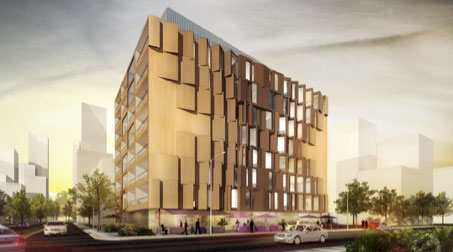
Jon Tanner, chief executive of the Wood Processors and Manufacturers Association says a wooden building weighs less than a steel concrete structure with obvious benefits in both construction and resilience in an earthquake. Source: Stuff NZ
After all it is standard for aircraft components to be monitored for performance real time – so why not buildings in quake zones?
But Callaghan Innovation’s apparent sole focus on finding more earthquake resistance through concrete technology, and particularly how to prevent steel rods from rusting when water gets through from earthquake cracks, is a one trick structural pony.
Wellington Airport domestic terminal extension features extensive use of glue laminated timber frames. We say simply – why not timber?
There are four reasons. First, there are intrinsic properties in wood we have known about and used for years. It is lightweight. A wooden building weighs less than a steel concrete structure with obvious benefits in both construction and resilience.
It is flexible. It can bend and stretch. The designed-in ‘snap-back’ quality is paramount in a quake. Victoria University Law School which is the largest wooden building in the southern hemisphere, came through the November earthquake unscathed.
Secondly, timber technology is more versatile now than the standard weatherboard, timber frame construction of a single or two-storey bungalow. Prominent local examples are the glue laminated timber frames used in the Wellington Airport Terminal extension.
Another Wellington instance of similar technology is the Massey University campus College of Creative Arts Building. A much more recent and already well proven case of engineered timber is the Kaikoura District Council building. It was built with a combination of two timber processing advances – laminated veneer lumber and cross laminated timber. You could call it very sophisticated plywood.
Laminated veneer lumber beams are stronger, straighter and more uniform than un-engineered timber supports.
Cross laminated timber panels can be made into large walls and flooring panels.
The Kaikoura building is three storeys of such panels with no concrete above the foundation. It was due to be handed over from the builders to the council the very day the magnitude 7.8 quake hit the district. There was no damage. Instead of the council moving in, emergency management teams were immediately able to use the building.
A third reason to use timber is its environmental benefits. Concrete manufacture produces greenhouse gasses. In contrast, a tree takes a lot of carbon out of the atmosphere and locks it up for the life of the tree. If the timber from that tree is used in construction the carbon lock lives on.
There are plenty of timber houses in Wellington built from trees which captured carbon out of the atmosphere more than 100 years ago, well before we had ever heard of global warming.
Plantation trees obviously have other environmental advantages of preventing erosion, cleaning streams and promoting an under-layer of biodiversity.
Fourthly, is the economic advantage of using domestically sourced building materials. A strong domestic market for processed timber construction products is a good foundation for getting an increased volume of processed timber into export markets.
If you don’t think we should export logs, then building confidence to invest in processing for local sales is the best way to achieve an export transfer to value added timber.
Consider these four reasons to use wood in the context of one of Wellington’s iconic buildings.
Tourists to Wellington are encouraged to visit the Victoria University Law School in Wellington. It is an old three story wooden building and unaffected by the quake which damaged many close-by, new and supposedly advanced structures.
The tourists don’t go there to be impressed by earthquake resistance. They want to visit the largest wooden building in the southern hemisphere. Our industry would like to see that record broken. Modern timber technology can safely push a timber construction up many more than three stories.
The Forte Apartments in Melbourne are 10 storeys of Cross Laminated Timber. The Brook Commons Building in Vancouver is 18 storeys with no concrete above the second floor.
We’d like to see Callaghan, and specifying designers and architects, check out the advances in timber construction and relearn a lesson Wellington learnt after the 1855 quake – timber is ideal.





